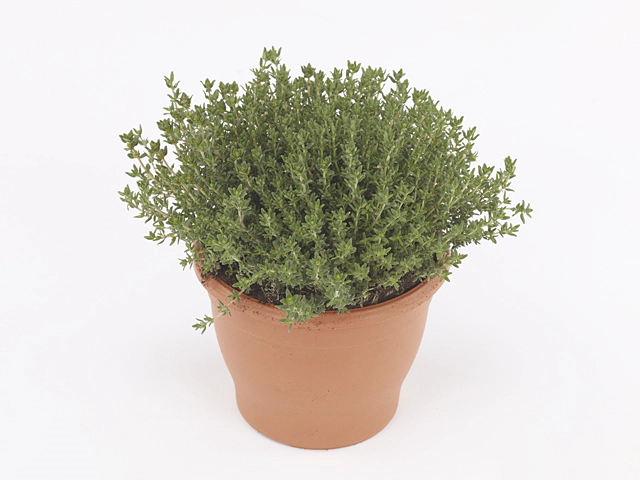Thymus vulgaris

| Leaf margin | Entire; Revolute |
| Flower scent | Different; Sweet scented |
| Leaf, scent | Pleasantly scented |
| Flowering month(s) | May; June; July |
| Leaf width | 0 - 1 cm |
| Fruit size | 30 - 40 cm |
| Leaf duration | Evergreen |
| Leaf size | 0 - 1 cm |
| soil pH requirement | Alkaline (pH > 7,5); Neutral (pH 6,5 - 7,5) |
| Light conditions | Sunny |
| Plant, growth type | Erect |
| Leaf, main color | Dark green |
| Flower, secondary color(s) | Light blue violet |
| Leaf, secondary color(s) | Greyish green |
| Moisture requirements | Well-drained |
Thyme, scientifically known as Thymus vulgaris, is a popular herb that is cherished not only for its culinary uses but also for its aesthetic appeal in gardens. This versatile plant has many characteristics that make it a favorite among garden enthusiasts.
One of the defining features of Thymus vulgaris is its leaf margin, described as entire and revolute. This means that the leaf edges are smooth and are rolled inward. The plant has small leaves, with a width ranging from 0 to 1 cm and a dark green color, making it a visually attractive addition to any garden.
In terms of scent, Thyme has a pleasant fragrance. The leaves emit a pleasing aroma that can be enjoyed as you brush against them or when used in cooking. The flower scent, however, is different and described as sweet-scented, adding another layer of olfactory delight to this herb.
Thyme blooms in the months of May, June, and July, producing small light blue-violet flowers. These delicate blossoms create a beautiful contrast against the dark green foliage. The plant has a growth type that is erect, meaning it grows upright, making it easy to incorporate into a garden design. Its compact and tidy growth habit makes it a perfect addition to borders, containers, or herb gardens.
Thymus vulgaris is an evergreen plant, meaning it retains its leaves year-round. This feature ensures that the plant remains visually appealing even in the colder months when other plants have shed their leaves. Additionally, Thyme is known for its ability to tolerate a variety of light conditions, thriving best in sunny areas. It is adaptable to different types of soil, with a preference for alkaline or neutral soil pH levels.
Another benefit of Thyme is its relatively low moisture requirements. It prefers well-drained soil, making it a resilient plant that can survive in drier conditions. This makes it an ideal choice for areas that receive less rainfall or for those who want a low-maintenance herb in their garden.
Thyme also has culinary uses beyond its aesthetic appeal. It is a staple herb in Mediterranean cuisine and is commonly used in soups, stews, marinades, and meat dishes. Its distinct flavor adds depth and complexity to various dishes, making it a versatile ingredient.
In conclusion, Thyme, or Thymus vulgaris, is a versatile herb that not only enhances the taste of various dishes but also adds visual interest to gardens. Its compact growth habit, dark green leaves, sweet scent, and delicate flowers make it a popular choice among gardeners. With its adaptability to different light conditions and soil types, Thyme is a resilient plant that effortlessly thrives in various gardening settings. Whether used as a culinary herb or as an ornamental plant, Thyme is a valuable addition to any garden.
Market availability index by month:
| Jan. | Feb. | Mar. | Apr. | May | Jun. | Jul. | Aug. | Sep. | Oct. | Nov. | Dec. |
|---|---|---|---|---|---|---|---|---|---|---|---|
| 2 | 3 | 3 | 3 | 4 | 3 | 3 | 2 | 1 | 1 | 1 | 1 |